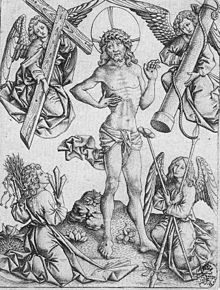Man of Sorrows

A man of pain (also: Imago pietatis , Erbärmdebild , man of pain , image of pity , misericord image or suffering Christ ) is a devotional image that depicts the suffering Jesus Christ with all the crucifixion wounds and the side wound, but alive and not on the cross.
history
The man of Sorrows in the form of the half-length Christ standing upright in the sarcophagus ("Gregorian Man of Sorrows") emerged in the 12th century in the Byzantine Eastern Church culture as the "King of Glory". An icon of this type of picture in the Roman church of Santa Croce in Gerusalemme was considered in the Middle Ages as an image initiated by Pope Gregory because of his vision of Christ (Gregory's mass). In connection with the worship of the Eucharist , which has increased since around 1300 , the Christian mysticism flowing into popular piety and the indulgences linked to depictions of the Man of Sorrows , this devotional image was also spread in the German-speaking area. In contrast to earlier depictions, Christ is not in the foreground as the shining king and victor over sin and death, but as a sufferer, to whom the viewer should develop an inner relationship. In the late Middle Ages, the Man of Sorrows, now shown in full figure, was enriched by additional figures (Maria, Johannes, angels), the mercy seat and the tools of suffering or the veil of Veronica . In representations of St. Gregory's Mass he appears to the celebrating Pope standing on the altar table. The Man of Sorrows differs from the Ecce-homo motif, which shows Christ after the flagellation with a crown of thorns, but without the stigmata of the crucifixion, as well as from the Engelspietà , where the body of Christ is mourned by angels.
Examples
Man of Sorrows and Angels, National Gallery, Prague
See also
- Tool of suffering
- Engelspietà
- Pietà (depiction of the body of Jesus in his mother's lap )
- Christ at rest
- Gregor's Mass
literature
- Romuald Bauerreiß : Pie Jesu. The Man of Sorrows image and its influence on medieval piety. Munich 1931.
- The “Gregorian” Man of Sorrows and the “Sacramentum Sancti Gregorii” in Andechs. In: Studies and communications on the history of the Benedictine order and its branches . Volume 44, New Series 13, Salzburg 1926, pp. 57–79.
- Rudolf Berliner: Comments on some depictions of the Redeemer as a Man of Sorrows. In: The Minster. 9, 1956, pp. 97-117.
- Gert von der Osten: The Man of Sorrows. Type history of a German devotional picture from 1300–1600 (= research on German art history. 7). Berlin 1935.
- Erwin Panofsky: "Imago Pietatis". A contribution to the type history of the “Man of Sorrows” and the “Maria Mediatrix”. In: Festschrift for Max J. Friedländer on the 60th birthday. Leipzig 1927, pp. 261-308.
- Hubert Schrade: Contributions to the explanation of the pain man image. In: German Studies. Friedrich Panzer on his 60th birthday (= contributions to recent literary history. 16), Heidelberg 1930, pp. 164–182.
- Andrea Zimmermann: Jesus Christ as the “Man of Sorrows” in high and late medieval representations of the fine arts: an analysis of their meaning. Dissertation (Dr. theol.), Martin Luther University Halle-Wittenberg, 1997 ( sundoc.bibliothek.uni-halle.de PDF)
Web links
- In Iconclass , the international iconographic classification system is a pain man with the code 73D73 connected.
- Man of Sorrows in the index of the art historical picture archive Foto Marburg
- Man of Sorrows in the index of the picture archive in the Rijksbureau voor Kunsthistorische Documentatie
- Peter Cornelius Claussen: The pain of the pictures. (in the Unimagazin of the University of Zurich, PDF; 3.9 MB)






